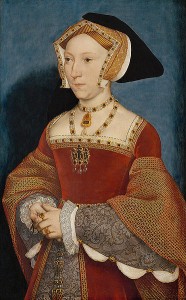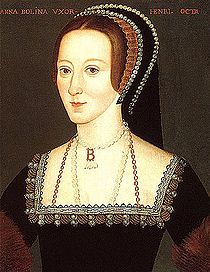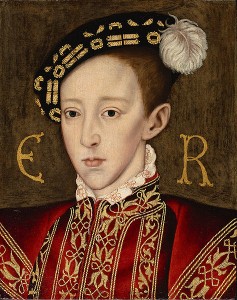
Today, we have a guest post by my good friend, Lauren Mackay, an historical researcher and consultant – thanks, Lauren!
Jane Seymour: Redefining the Myth
by Lauren Mackay
It is hard to find many people who are as fond of Jane Seymour as they are Anne Boleyn (and vice versa). This is not difficult to understand, as the rivalry between the two women culminated in the execution of one and the royal marriage of the other. The lines have been firmly drawn since the 16th Century, and the for the most part people are either “Team Anne” or “Team Jane”. However, modern historians have uncovered more information about Jane Seymour, her character and her beliefs, which suggest that Anne and Jane may have had more in common than we think. This article in no way favours Jane over Anne, but offers a more balanced portrait of her. Jane is always described as Anne’s opposite-submissive, meek and silent, never complaining – the perfect wife. She is also usually dismissed as a dim witted, dull woman, but that gives us a rather one sided and ultimately unfulfilling portrayal of the woman who successfully drew the King away from his most entirely beloved Anne.
One of the most common misconceptions about Jane was that she was uneducated. However, her education is compared to that of her predecessors; Katherine of Aragon and Anne Boleyn, both of which had an almost unconventional education. Katherine had received a royal education, equal to that of her brothers. She was taught military tactics and diplomacy, both of which she put to good use in England. Anne, was well educated in France and the Netherlands, and returned to England a sophisticated and cultured young woman. Jane’s education paled in comparison, but she had a traditional education for a 16th century woman. Her education was sufficient for a gentleman’s daughter, and Jane – along with her younger sisters Dorothy and Elizabeth – was taught all the accomplishments for a typical English woman.
There was speculation, mostly by historian Agnes Strickland, that Jane finished her education in France. The basis for this is a supposed portrait in the Louvre, which has a very vague similarity to her official portrait. There is evidence that Jane was able to read and write, and could understand French and Latin, and would have had a hard time avoiding them, serving in the pious Catholic household of Katherine, and the witty, “frenchified” household of Anne’s. Contrary to popular belief, she did learn music, and she had a particular skill for needlework, some of which was preserved in the royal collection. According to Elizabeth Norton, author of “Jane Seymour, Henry VIII’s true love” Jane was an expert horsewoman and enjoyed following the hunt. However there are no sources available to corroborate this statement, so we can only assume that as horse riding was part of a country woman’s education, she was adept at it.

Certainly Jane was the 16th century man’s, (and especially Henry’s) ideal “little woman”1. She was considered to be soft spoken, docile and subservient. Physically, Anne and Jane were night and day. Jane was pale, as Chapuys writes rather bluntly “Her complexion is so whitish that she may be called rather pale”2. Interestingly, she is not described at first by Chapuys as a meek obedient woman, and he continues, saying “is said to be rather proud and haughty”, which clashes somewhat with other assertions about her. There is evidence that Jane was ambitious, certainly as ambitious as Anne, but it was a quiet and determined ambition, carefully nurtured by her supporters. Her supporters, apart from her immediate family, included Sir Nicholas Carew, a cousin of Anne Boleyn’s who actively worked against her and mentored Jane in how to keep the King’s interest.
Agnes Strickland was one of the first historians to dispute the traditional view of the submissive Jane. She accuses her of passively watching Anne Boleyn suffer, and proceeding with her plans regardless of the fact that Henry’s inconstancy nearly destroyed Anne, and caused her miscarriage3. Historian David Starkey has a similar view of Jane, and queries whether she was truly such a door mat as later described. Was it such a different situation from Anne supplanting Katherine? The answer, simply, is no. Jane found herself in the same position that Anne once enjoyed, and Anne experienced that terrible and dangerous position of an unwanted wife
It cannot be denied that the Seymours actively worked against Anne, and plotted to replace her with Jane. One of the first examples of the strategies employed by the Seymours is the rather hasty change of their family crest. Originally the Seymour crest comprised of a Peacock’s head and neck, its wings in mid flight. As David Starkey points out, Peacocks traditionally represented pride – hardly something that the Seymours would not want affiliated with Jane, as the badge had to reflect the projected idea of Jane as meek and subservient. It was quickly remedied, with a few brushstrokes transforming the Peacock to a Phoenix – the symbol of self sacrifice. The new crest is almost prophetic, as of course Jane was in a way sacrificed in the birth of the son and heir of the King.
Anne had set a pattern for Jane to follow, playing on her virtue and refusing Henry’s advances, unless they were married – Jane proved she could play that game too. When one looks at Jane’s childhood and takes into consideration that she was overlooked in her family, watching as her brothers’ rose, her younger sister married off, is it hardly surprising that Jane might have hoped for something more in life than spinsterhood. Her parents certainly did nothing to advance her, at least, in terms of marriage, and the unsavoury family scandal – an affair between her father and her brother Edward’s first wife- that was made public may have accounted for the lack of suitors once she returned to court under Anne’s reign. Jane, like Anne, served Queen Katherine.
Unlike Anne however, she had a great affection for the Queen, and came to admire her and her daughter, Mary. What she thought of Anne, the woman who possibly in her eyes (what woman would dare blame the King?) was responsible for the misery and pain inflicted on Katherine, we can only assume. But we can imagine that she watched, silently, as the drama went on around her. It is more than likely that it was at this time that she developed her own views about Anne, and certainly didn’t seem to feel any discomfort sitting on a so recently occupied throne.
Jane was coached carefully by Nicholas Carew, and as Eric Ives notes, that she was encouraged to poison Henry’s mind against his wife, and presenting herself as an implicit alternative4. Jane was probably forewarned, and made a rather theatrical display of virtue when Henry sent her a purse full of coins with a letter. She was clever enough not to open the letter, as Ives points out, and returned it unopened. It was a tactful way of extricating herself from an undesired situation: being propositioned. Playing hard to get was always something that Anne excelled at. She was a master of going forward, then drawing back, and always protesting her virtue. Jane had clearly learnt more from Anne Boleyn that she would care to admit, and Henry fell for the same trick twice. “In fact, it will not be Carew’s fault if the aforesaid concubine, though a cousin of his, is not overthrown (desarçonee) one of these days, for I hear that he is daily conspiring against her, and trying to persuade Miss Seymour and her friends to accomplish her ruin”5.
The coup against Anne moved quickly, with Jane quickly stepping in to replace Anne, but Jane was not as well loved by the people as some historians have suggested. The people found it hard to believe that Henry had a convenient backup wife in the wings, while his present wife’s name was being dragged through the mud. Chapuys observed that “although everybody rejoices at the execution of the putain, there are some who murmur at the mode of procedure against her and the others, and people speak variously of the King.”6 He remarks in a letter to Nicolas Perrenot de Granvelle that “you never saw a prince nor man who made greater show of his [cuckold’s] horns. Or bore them more pleasantly. I leave you to imagine the case”7 The case was pretty obvious – and perhaps Jane felt the same vulnerability that Anne once did, coping with the public’s mood, perhaps clinging to the only man who could shelter her from the potential storm: Henry.
Jane might have publicly been meek, but before Anne was even executed she rather uncharacteristically stood up to Henry and pleaded with him to restore Mary to the succession. It did not go as well as she had hoped. Chapuys reports that “I hear that, even before the arrest of the Concubine, The King, speaking with mistress Jane [Seymour] of their future marriage, the latter suggested that the Princess should be replaced in her former position; and the King told her she was a fool, and ought to solicit the advancement of the children they would have between them, and not any others.”8 Jane could have taken the hint, but she continued: “She replied that in asking for the restoration of the Princess she conceived she was seeking the rest and tranquillity of the King, herself, her future children, and for the whole realm for without that, neither your Majesty nor his people would ever be content”9. Chapuys adds something to this report which exemplifies his own feelings on her plea “Will endeavour by all means to make her continue in this vein”.
Jane did continue in this vein, but did not approach Henry directly on the issue again. However, she could not keep all her personal feelings to herself, when rebels who led the Pilgrimage of Grace demanded Henry restore the Catholic Church. They also demanded that the recently dissolved and destroyed monasteries be re-established. Jane’s sympathies clearly lay with the rebels, and despite a firm warning from Henry, she “threw herself onto her knees and begged Henry to restore the abbeys, suggesting that God, angered by their destruction, had sent the rebellions as punishments.” If Henry thought he was past argumentative wives, he was mistaken, and his response was of no surprise. He furiously ordered Jane to get up and reminded her of the fate of other queens who dared meddle in his affairs. The Frenchman who recorded the incident goes on to add “It was enough to frighten a woman is not very secure”10. The threat was clear, and Jane, unlike Anne, heard the warning.

Of all the wives, Jane satisfied Henry’s need for an heir. She did not live long enough to enjoy her great success, and instead endured a slow death. It is believed that Henry was not with her when she died, her torn and exhausted body finally giving in. Jane possessed personal strength, but she kept it hidden, restrained beneath a gentle exterior. Where Anne would run towards an issue, Jane would draw back. I do not suggest that drawing back or keeping silent was an indication of her intelligence, but rather she was able to adapt more easily to Henry’s mercurial temper, and knew when to let a point go.
Few can deny that the official portrait of Jane, with her weak chin and pallor, is bland, so bland in comparison with the striking portraits of Anne. But it is this blandness that has allowed historians to treat Jane as a blank canvas, projecting their own personal views of her, dismissing the inner strength that, like Anne, she possessed. She is harshly judged for usurping Anne, and accused of having no sympathy or empathy for anyone around her. We cannot possibly know what she may or may not have felt, just as we don’t truly know if Anne felt any sympathy for Katherine when she replaced her. Both women had ambitions and played their own personal games of seduction. All who adore Anne remember well that she was once vilified by history as a schemer, a wh*re and a home wrecker. It is only in recent times that a real attempt has been made to rehabilitate her; perhaps it is now Jane’s turn.
Notes
- David Starkey: Six Wives: The Queens of Henry VIII, Chatto & Windus, 2003, p.586
- Letters and Papers, Foreign and Domestic, Henry VIII, Volume 10: January-June 1536, 1887, pp. 371-391.
- Agnes Strickland: Lives of the queens of England, from the Norman conquest: with anecdotes of their courts, now first published from official records and other authentic documents, private as well as public, Volume 2, Taggard & Thompson, 1864, p.216
- Eric Ives, The life and death of Anne Boleyn: ‘the most happy’, Wiley-Blackwell, 2004, p.304
- Calendar of State Papers, Spain, Volume 5 Part 2: 1536-1538, 1888, pp. 104-118.
- Letters and Papers, Henry VIII, volume 10, January – June 1536, 1887 p. 908
- Calendar of State Papers, Volume 5, part 2, p.908
- Letters and Papers, Henry VIII, Volume 10,pp. 371-391
- Ibid.
- Letters and papers, Henry VIII, volume 10, p. 860
Sources
Primary
Letters and Papers, Foreign and Domestic, Henry VIII, Volume 10: January-June 1536, 1887
Calendar of State Papers, Spain, Volume 5 Part 2: 1536-1538, 1888
Secondary Sources
Antonia Fraser: The Six Wives of Henry VIII, Phoenix, 2002
Eric Ives: The Life and Death of Anne Boleyn: ‘the most happy’, Wiley-Blackwell, 2004
Elizabeth Norton: Jane Seymour: Henry VIII’s True Love, Amberley Publishing, 2009
Agnes Strickland: Lives of the queens of England, from the Norman conquest: with anecdotes of their courts, now first published from official records and other authentic documents, private as well as public, Volume 2, Taggard & Thompson, 1864
David Starkey: Six Wives: The Queens of Henry VIII, Chatto & Windus, 2003
Alison Weir: The Six Wives of Henry VIII, Grove Press, 2000
Lauren has her own website at http://www.lauren-mackay.com/ which is currently being developed.